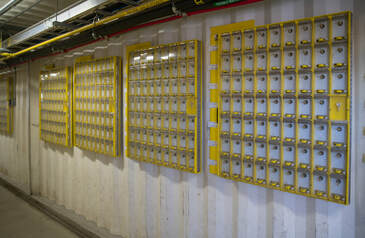The dry room, shifter's or mine wicket and the cage are integral parts of underground employees’ daily routines. The dry room is where the miners change into their work uniforms and safety gear. Underground employees get their work assignments in the shifter’s wicket before taking the cage underground. As a safety precaution, everyone going underground must 'tag in' at the tag board before heading down into the mine.
|
Dry Room The dry room or simply the dry is a mine’s version of a locker or change room. It is where mine employees store their street clothes during their shifts and their uniform afterwards. Although used by all mine employees, the dry room got its name because miners need to let their uniforms dry after their shift. Wet uniforms are hung on baskets, then hoisted to hang near the ceiling for ventilation and warmth. If uniforms need to be laundered, the ‘dryman’ cleans them before the miner’s next shift. Miners also keep tool bags with necessary small equipment like a saw and bit knockers with their uniforms. Standard uniform or Personal Protective Equipment (PPE) elements for most mine employees consist of coveralls, boots, gloves, safety glasses and a helmet. The PPE differs slightly in material, purpose and durability depending where in the mine the employee is working. |
|
|
Shifter's Wicket
The shifter's wicket is the main space where miners get information before going underground. At the beginning of their shifts, miners gather to receive their work assignments and any essential safety information from their supervisor. Some mining operations have shifted away from this system, preferring meeting in smaller work groups for communication and teamwork. Located in or near the shifter's wicket, the tag board is a standard safety feature used by underground mines worldwide to keep track of where their underground employees are. Employees ‘tag in’ at the beginning of each shift, hanging their name tag wherever they are going to be working that shift. Every employee has to ‘tag out’ or remove their name tag at the end of their shift. If someone forgets to remove their tag, they are called back to work to remove it. Blasting can only happen once the tag board is completely cleared. Tag boards are also imperative during emergencies so management and mine rescue teams know where underground employees are. |
|
Cage The cage is part of the transportation system that moves people and equipment up and down the mine shaft. While commonly thought of as a standard elevator, the cage is controlled by a hoist in separate building. Together with the hoist - a system of cables, motors and counterbalance weights - the cage can carry heavy loads and move at high speeds. Since the cage and hoist are housed separately, two people, a hoistman and a cage tender, are needed to operate the cage. A system of bell signals is used to communicate where the cage is required. The cage tender interprets the Morse code-style signals and signals the hoistman where to send the cage. The hoistman uses levers to raise and lower the cage based on the signals from the cage tender. |
|
Were You Afraid to Work Underground?
Timeline
Historic Red Lake Mining
Red Lake Geology
The Red Lake Gold Rushes
From Hudson to Headframe
Community Development
Commerce
Education
Medicine
Recreation
Mining Practices
Going Underground
Equipment
Extraction
Milling
The Mill Process
Safety
Refuge Station
Mine Rescue
Health Issues
Jobs
Contemporary Red Lake Mining
Environment
Labour
Innovation
Exploration
Indigenous Rights
Gold Prices
Mining and Exploration Companies
Goldcorp Inc.
Rubicon Minerals
Premier Gold Mines
Pure Gold Mining
Rimini Exploration & Consulting
Other Mining & Exploration Companies
Glossary


